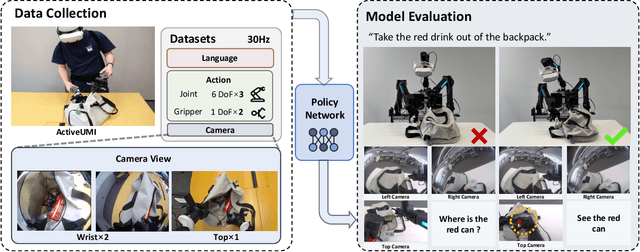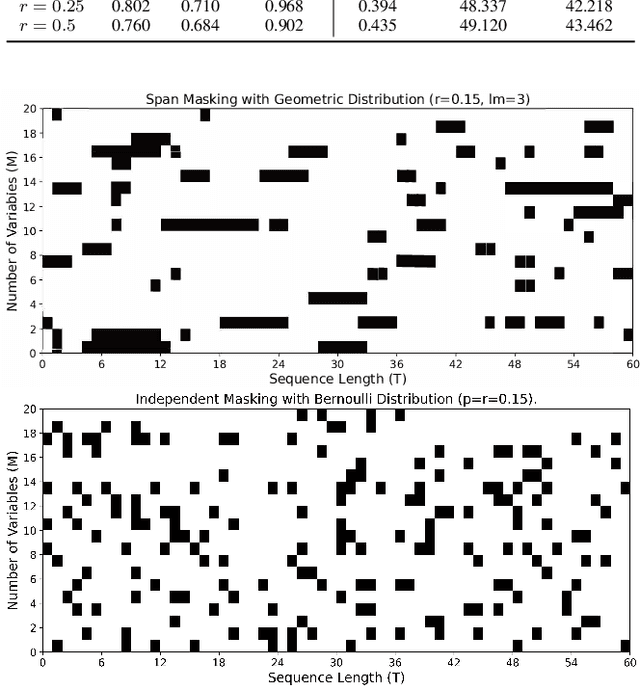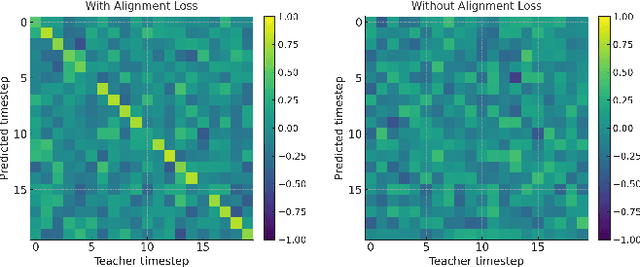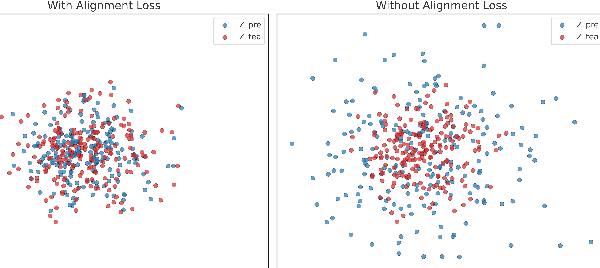Yi Xu
G3Splat: Geometrically Consistent Generalizable Gaussian Splatting
Dec 19, 2025Abstract:3D Gaussians have recently emerged as an effective scene representation for real-time splatting and accurate novel-view synthesis, motivating several works to adapt multi-view structure prediction networks to regress per-pixel 3D Gaussians from images. However, most prior work extends these networks to predict additional Gaussian parameters -- orientation, scale, opacity, and appearance -- while relying almost exclusively on view-synthesis supervision. We show that a view-synthesis loss alone is insufficient to recover geometrically meaningful splats in this setting. We analyze and address the ambiguities of learning 3D Gaussian splats under self-supervision for pose-free generalizable splatting, and introduce G3Splat, which enforces geometric priors to obtain geometrically consistent 3D scene representations. Trained on RE10K, our approach achieves state-of-the-art performance in (i) geometrically consistent reconstruction, (ii) relative pose estimation, and (iii) novel-view synthesis. We further demonstrate strong zero-shot generalization on ScanNet, substantially outperforming prior work in both geometry recovery and relative pose estimation. Code and pretrained models are released on our project page (https://m80hz.github.io/g3splat/).
Distillation-Guided Structural Transfer for Continual Learning Beyond Sparse Distributed Memory
Dec 17, 2025Abstract:Sparse neural systems are gaining traction for efficient continual learning due to their modularity and low interference. Architectures such as Sparse Distributed Memory Multi-Layer Perceptrons (SDMLP) construct task-specific subnetworks via Top-K activation and have shown resilience against catastrophic forgetting. However, their rigid modularity limits cross-task knowledge reuse and leads to performance degradation under high sparsity. We propose Selective Subnetwork Distillation (SSD), a structurally guided continual learning framework that treats distillation not as a regularizer but as a topology-aligned information conduit. SSD identifies neurons with high activation frequency and selectively distills knowledge within previous Top-K subnetworks and output logits, without requiring replay or task labels. This enables structural realignment while preserving sparse modularity. Experiments on Split CIFAR-10, CIFAR-100, and MNIST demonstrate that SSD improves accuracy, retention, and representation coverage, offering a structurally grounded solution for sparse continual learning.
FaultDiffusion: Few-Shot Fault Time Series Generation with Diffusion Model
Nov 19, 2025Abstract:In industrial equipment monitoring, fault diagnosis is critical for ensuring system reliability and enabling predictive maintenance. However, the scarcity of fault data, due to the rarity of fault events and the high cost of data annotation, significantly hinders data-driven approaches. Existing time-series generation models, optimized for abundant normal data, struggle to capture fault distributions in few-shot scenarios, producing samples that lack authenticity and diversity due to the large domain gap and high intra-class variability of faults. To address this, we propose a novel few-shot fault time-series generation framework based on diffusion models. Our approach employs a positive-negative difference adapter, leveraging pre-trained normal data distributions to model the discrepancies between normal and fault domains for accurate fault synthesis. Additionally, a diversity loss is introduced to prevent mode collapse, encouraging the generation of diverse fault samples through inter-sample difference regularization. Experimental results demonstrate that our model significantly outperforms traditional methods in authenticity and diversity, achieving state-of-the-art performance on key benchmarks.
Towards High-Consistency Embodied World Model with Multi-View Trajectory Videos
Nov 19, 2025Abstract:Embodied world models aim to predict and interact with the physical world through visual observations and actions. However, existing models struggle to accurately translate low-level actions (e.g., joint positions) into precise robotic movements in predicted frames, leading to inconsistencies with real-world physical interactions. To address these limitations, we propose MTV-World, an embodied world model that introduces Multi-view Trajectory-Video control for precise visuomotor prediction. Specifically, instead of directly using low-level actions for control, we employ trajectory videos obtained through camera intrinsic and extrinsic parameters and Cartesian-space transformation as control signals. However, projecting 3D raw actions onto 2D images inevitably causes a loss of spatial information, making a single view insufficient for accurate interaction modeling. To overcome this, we introduce a multi-view framework that compensates for spatial information loss and ensures high-consistency with physical world. MTV-World forecasts future frames based on multi-view trajectory videos as input and conditioning on an initial frame per view. Furthermore, to systematically evaluate both robotic motion precision and object interaction accuracy, we develop an auto-evaluation pipeline leveraging multimodal large models and referring video object segmentation models. To measure spatial consistency, we formulate it as an object location matching problem and adopt the Jaccard Index as the evaluation metric. Extensive experiments demonstrate that MTV-World achieves precise control execution and accurate physical interaction modeling in complex dual-arm scenarios.
GRLoc: Geometric Representation Regression for Visual Localization
Nov 17, 2025Abstract:Absolute Pose Regression (APR) has emerged as a compelling paradigm for visual localization. However, APR models typically operate as black boxes, directly regressing a 6-DoF pose from a query image, which can lead to memorizing training views rather than understanding 3D scene geometry. In this work, we propose a geometrically-grounded alternative. Inspired by novel view synthesis, which renders images from intermediate geometric representations, we reformulate APR as its inverse that regresses the underlying 3D representations directly from the image, and we name this paradigm Geometric Representation Regression (GRR). Our model explicitly predicts two disentangled geometric representations in the world coordinate system: (1) a ray bundle's directions to estimate camera rotation, and (2) a corresponding pointmap to estimate camera translation. The final 6-DoF camera pose is then recovered from these geometric components using a differentiable deterministic solver. This disentangled approach, which separates the learned visual-to-geometry mapping from the final pose calculation, introduces a strong geometric prior into the network. We find that the explicit decoupling of rotation and translation predictions measurably boosts performance. We demonstrate state-of-the-art performance on 7-Scenes and Cambridge Landmarks datasets, validating that modeling the inverse rendering process is a more robust path toward generalizable absolute pose estimation.
ActiveUMI: Robotic Manipulation with Active Perception from Robot-Free Human Demonstrations
Oct 02, 2025



Abstract:We present ActiveUMI, a framework for a data collection system that transfers in-the-wild human demonstrations to robots capable of complex bimanual manipulation. ActiveUMI couples a portable VR teleoperation kit with sensorized controllers that mirror the robot's end-effectors, bridging human-robot kinematics via precise pose alignment. To ensure mobility and data quality, we introduce several key techniques, including immersive 3D model rendering, a self-contained wearable computer, and efficient calibration methods. ActiveUMI's defining feature is its capture of active, egocentric perception. By recording an operator's deliberate head movements via a head-mounted display, our system learns the crucial link between visual attention and manipulation. We evaluate ActiveUMI on six challenging bimanual tasks. Policies trained exclusively on ActiveUMI data achieve an average success rate of 70\% on in-distribution tasks and demonstrate strong generalization, retaining a 56\% success rate when tested on novel objects and in new environments. Our results demonstrate that portable data collection systems, when coupled with learned active perception, provide an effective and scalable pathway toward creating generalizable and highly capable real-world robot policies.
Closing the Oracle Gap: Increment Vector Transformation for Class Incremental Learning
Sep 26, 2025Abstract:Class Incremental Learning (CIL) aims to sequentially acquire knowledge of new classes without forgetting previously learned ones. Despite recent progress, current CIL methods still exhibit significant performance gaps compared to their oracle counterparts-models trained with full access to historical data. Inspired by recent insights on Linear Mode Connectivity (LMC), we revisit the geometric properties of oracle solutions in CIL and uncover a fundamental observation: these oracle solutions typically maintain low-loss linear connections to the optimum of previous tasks. Motivated by this finding, we propose Increment Vector Transformation (IVT), a novel plug-and-play framework designed to mitigate catastrophic forgetting during training. Rather than directly following CIL updates, IVT periodically teleports the model parameters to transformed solutions that preserve linear connectivity to previous task optimum. By maintaining low-loss along these connecting paths, IVT effectively ensures stable performance on previously learned tasks. The transformation is efficiently approximated using diagonal Fisher Information Matrices, making IVT suitable for both exemplar-free and exemplar-based scenarios, and compatible with various initialization strategies. Extensive experiments on CIFAR-100, FGVCAircraft, ImageNet-Subset, and ImageNet-Full demonstrate that IVT consistently enhances the performance of strong CIL baselines. Specifically, on CIFAR-100, IVT improves the last accuracy of the PASS baseline by +5.12% and reduces forgetting by 2.54%. For the CLIP-pre-trained SLCA baseline on FGVCAircraft, IVT yields gains of +14.93% in average accuracy and +21.95% in last accuracy. The code will be released.
AdaSports-Traj: Role- and Domain-Aware Adaptation for Multi-Agent Trajectory Modeling in Sports
Sep 19, 2025Abstract:Trajectory prediction in multi-agent sports scenarios is inherently challenging due to the structural heterogeneity across agent roles (e.g., players vs. ball) and dynamic distribution gaps across different sports domains. Existing unified frameworks often fail to capture these structured distributional shifts, resulting in suboptimal generalization across roles and domains. We propose AdaSports-Traj, an adaptive trajectory modeling framework that explicitly addresses both intra-domain and inter-domain distribution discrepancies in sports. At its core, AdaSports-Traj incorporates a Role- and Domain-Aware Adapter to conditionally adjust latent representations based on agent identity and domain context. Additionally, we introduce a Hierarchical Contrastive Learning objective, which separately supervises role-sensitive and domain-aware representations to encourage disentangled latent structures without introducing optimization conflict. Experiments on three diverse sports datasets, Basketball-U, Football-U, and Soccer-U, demonstrate the effectiveness of our adaptive design, achieving strong performance in both unified and cross-domain trajectory prediction settings.
MTS-DMAE: Dual-Masked Autoencoder for Unsupervised Multivariate Time Series Representation Learning
Sep 19, 2025



Abstract:Unsupervised multivariate time series (MTS) representation learning aims to extract compact and informative representations from raw sequences without relying on labels, enabling efficient transfer to diverse downstream tasks. In this paper, we propose Dual-Masked Autoencoder (DMAE), a novel masked time-series modeling framework for unsupervised MTS representation learning. DMAE formulates two complementary pretext tasks: (1) reconstructing masked values based on visible attributes, and (2) estimating latent representations of masked features, guided by a teacher encoder. To further improve representation quality, we introduce a feature-level alignment constraint that encourages the predicted latent representations to align with the teacher's outputs. By jointly optimizing these objectives, DMAE learns temporally coherent and semantically rich representations. Comprehensive evaluations across classification, regression, and forecasting tasks demonstrate that our approach achieves consistent and superior performance over competitive baselines.
Out-of-Sight Trajectories: Tracking, Fusion, and Prediction
Sep 18, 2025Abstract:Trajectory prediction is a critical task in computer vision and autonomous systems, playing a key role in autonomous driving, robotics, surveillance, and virtual reality. Existing methods often rely on complete and noise-free observational data, overlooking the challenges associated with out-of-sight objects and the inherent noise in sensor data caused by limited camera coverage, obstructions, and the absence of ground truth for denoised trajectories. These limitations pose safety risks and hinder reliable prediction in real-world scenarios. In this extended work, we present advancements in Out-of-Sight Trajectory (OST), a novel task that predicts the noise-free visual trajectories of out-of-sight objects using noisy sensor data. Building on our previous research, we broaden the scope of Out-of-Sight Trajectory Prediction (OOSTraj) to include pedestrians and vehicles, extending its applicability to autonomous driving, robotics, surveillance, and virtual reality. Our enhanced Vision-Positioning Denoising Module leverages camera calibration to establish a vision-positioning mapping, addressing the lack of visual references, while effectively denoising noisy sensor data in an unsupervised manner. Through extensive evaluations on the Vi-Fi and JRDB datasets, our approach achieves state-of-the-art performance in both trajectory denoising and prediction, significantly surpassing previous baselines. Additionally, we introduce comparisons with traditional denoising methods, such as Kalman filtering, and adapt recent trajectory prediction models to our task, providing a comprehensive benchmark. This work represents the first initiative to integrate vision-positioning projection for denoising noisy sensor trajectories of out-of-sight agents, paving the way for future advances. The code and preprocessed datasets are available at github.com/Hai-chao-Zhang/OST
 Add to Chrome
Add to Chrome Add to Firefox
Add to Firefox Add to Edge
Add to Edge